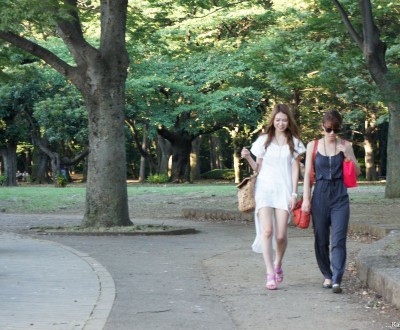Japan: Land of Women
There is a stereotype of Japan, as in so many other areas, that the man spends all his time at work leaving his wife behind to play the role of the good little housewife. The Japanese man is not very courteous and won’t change because his wife is so under the thumb that she would not dare to protest, or so the cliché goes.
To some extent, this view seen through Western eyes is not entirely inaccurate. It has fed into the outrageous claims of Julien Blanc, the controversial American “pickup artist”, which have thankfully been shouted down by many people, at least superficially.
The Japanese media themselves play with the idea of the “weaker sex”, stereotyping the ideal Japanese woman:
- a kawaii face, cute but not sexy with natural makeup
- vital statistics: 160cm tall (5ft 2ins), 48 kilogrammes (106 pounds) and a C cup bra size (according to the Japanese calculations)
- smelling of soap
- hobbies: cooking / animals: a small dog / favourite manga: One Piece
- works part-time at a cafe
- good grades but not top of the class
- doesn’t like physical exercise…
No wonder the Japanese woman is put on a idol pedestal and objectified.
The fact is that, according to reports from the OECD and the international economic forum, in 2013 only 63 per cent of Japanese women had a job, of which 35 per cent worked part-time or baito, compared with 85 per cent and 10 per cent respectively of their male counterparts. More than half of Japanese women quit their jobs when their first child is born. In the event of divorce, the overwhelming majority of them retain custody of their children.
Of course, sometimes the big picture hides a more complex reality.
The Japanese woman at the heart of her own society
Have you ever strolled around Japan during the day on a weekday, during office hours? Apart from in the countryside where you’ll mainly see pensioners (the Japanese being the main tourists in their own country), large cities and especially shopping centers are a perfect illustration: strikingly, the majority of the people there are women of all ages from their twenties to their fifties.
In Japan, this household icon is more than just a cliché: once married, the little Japanese princess holds the household purse strings. And the marketing machine hasn’t missed a trick - it rolls out the red carpet for them.
Some subway 🚇 companies in Tokyo even provide 女性専用車 “Women Only” carriages during the morning rush hour, to protect women from 痴漢 chikan, those pests who want to snatch a photo or even touch them (some people even claim it is the women's fault because of the way they are dressed). If the surveys carried out by these same companies are to be believed, 70 per cent of women have been a victim of this at least once.
In the same vein, lots of places offer discounts to young ladies, not just at the entrances to nightclubs, but also in restaurants, bars and cinemas. In addition, the number of women’s magazines available on newsstands or konbini borders on the absurd, while the advice in all of them is exactly the same. As for Japanese advertising, whatever the medium, it seems to mainly target women.
Even more extraordinarily, from an outsider’s point of view, in the toilets of department stores, and even in the Shinkansen 🚅, there are makeup rooms. And Japanese toilets 🚽 even make different sounds to mask 😷 the possibly less elegant natural sounds that are coming from within.
Finally, Japan has to be one of the few countries in the world where the most intimate leisure activities are not reserved for men. So the maid cafes have their counterparts with 執事喫茶 shitsuji kissa and bars with male hosts, of which there now seem to be almost more than those with hostesses for men.
It smacks of masculinity
Some strongly believe that Japanese women have progressively taken back power after the war, on the back of Americanism and rampant consumer capitalism.
The fact is that Japan has long worked to keep its women in the shadows, something that can still be seen today sometimes in the most surprising places. Thus climbing Mount Omine, the sacred Shinto mountain in Nara Prefecture, is purely and simply reserved for men!
In 2014, the visual artist Rokudenashiko, aka Megumi Igarashi, made headlines in the world’s press, before being sentenced to two years in prison at the end of the year for violating the obscenity law. Her crime? Showing a 3D scan of her vagina after a crowd-funding project and making a moulded canoe based on the scan.
Yet every first Sunday in April, hordes of tourists flock with indecent haste to Kanamara matsuri, not far from Tokyo for... a Shinto fertility festival where people carry giant penises.
While politicians still manage to make female members of parliament cry with degrading sexist remarks, it seems once again that Miyazaki was right: are the Mamma Aiuto gang, the big children in his animation movie Porco Rosso, not an accurate representation of many childish Japanese males?

